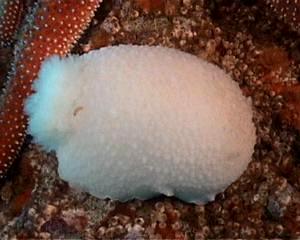
Archidoris odhneri
(MacFarland, 1966)
Order: NUDIBRANCHIA
Suborder: DORIDINA
Superfamily: EUDORIDOIDEA
Family: Dorididae
DISTRIBUTION
Alaska to California.
PHOTO
California. Photo: Clinton Bauder.
The body is of a uniform colour, usually white, but Behren's reports a yellow colour form from Puget Sound and British Columbia. Grows to 20cm.
See Clinton Bauder's message comparing this species and Archidoris montereyensis.
Archidoris odhneri or Doris odhneri? - see message #20329.
-
MacFarland, F.M. (1966) Studies of opisthobranchiate mollusks of the Pacific coast of North America. Memoirs of the California Academy of Sciences, 6: 1-546.
Rudman, W.B., 2000 (October 12) Archidoris odhneri (MacFarland, 1966). [In] Sea Slug Forum. Australian Museum, Sydney. Available from http://www.seaslugforum.net/find/archodhn
Related messages
Behaviour of Doris odhneri
July 30, 2008
From: Jackie Hildering & Glen Miller
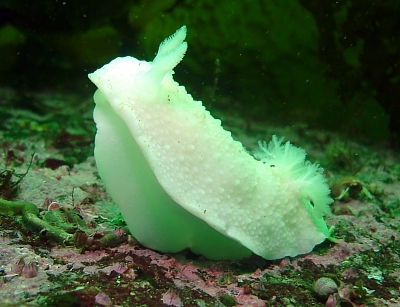
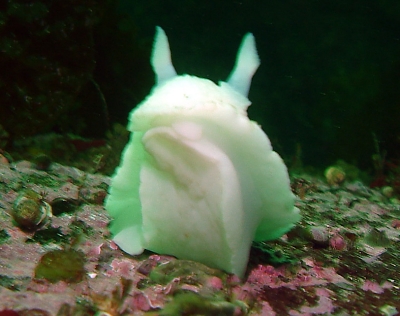
This individual remained suspended in this position despite the "distraction" of two divers repeatedly taking photos of it at close proximity. It was definitely alive as it briefly retracted its brachial plume when I wafted my hand above it. We have never seen this "stance" before and certainly find it unusual that it did not immediately retract the brachial plume.
Any insights Dave?
Locality: Five Fathom Rock, Port Hardy, 40', British Columbia, Canada, Port Hardy Bay (Pacific Ocean), 01 April 2007, Rocky bottom. Length: 15 cm. Photographer: Jackie Hildering and Glen Miller.
Great thanks,
Jackie
earthlingenterprises@telus.net
Hildering, J. & Miller, G., 2008 (Jul 30) Behaviour of Doris odhneri. [Message in] Sea Slug Forum. Australian Museum, Sydney. Available from http://www.seaslugforum.net/find/19812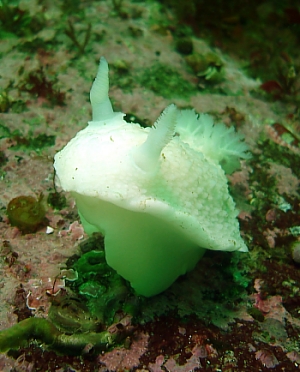
Dear Jackie and Glen,
I will agree the "rearing" is unusual in this group of dorids. Rearing is common amoung phanerobranch dorids (those that cannot withdraw their gill), as discussed in my book - Nudibranch Behavior.
Although we will never know for sure, the behavior is thought to be a way for the slug to elevate itself above the substrate in search of chemical clues for its favorite prey.
Best wishes,
Dave Behrens
Are Doris odhneri and Archidoris odhneri synonyms ?
August 1, 2007
From: Ron Silver
Concerning message #20168:
Bill,
Are Doris odhneri and Archidoris odhneri synonyms I note both names are utilized for this species on the Sea Slug Forum?
Thanx.
Ron Silver
rhinopias@comcast.net
Silver, R., 2007 (Aug 1) Are Doris odhneri and Archidoris odhneri synonyms ?. [Message in] Sea Slug Forum. Australian Museum, Sydney. Available from http://www.seaslugforum.net/find/20329Dear Ron,
As I have discussed a number of times I have some difficulties with parts of Angel Valdés's (2002) analysis of the cryptobranch dorids. One of these difficulties revolves around his examination only of the type species of each genus [see message #19925]. Even if his analysis does prove to be correct and we synonymise many genera - for example Archidoris is a synonym of Doris - it does not necessarily follow that all the species that previously were placed in Archidoris should be moved to Doris until their anatomy is re-examined. For example both A. montereyensis and A. odhneri have tripinnate gills so should never have been in Archidoris in the first place because one of the characters of the type species was unipinnate gills. The branching of the gills may turn out to be unimportant but it does illustrate the point that all the species in the genera which Valdés has synonymised need to be examined before being reallocated to different genera to see where they really should go. Otherwise we are just compounding existing errors.
This also is a problem arising from Valdés & Gosliner's, 2001 paper [see message #16240] where Anisodoris and Diaulula were synonymised but species like Anisodoris nobilis [now placed in Peltodoris] were essentially left in limbo.
Which brings us back to Archidoris odhneri. Dave Behrens (2004) has moved both A. montereyensis and A. odhneri to Doris on the grounds they both have rounded tubercles without protruding spicules. I don't know if that is sufficient justification. In Angel Valdes earlier message [#16240] he says:
"It would be a very time consuming task to review all species of cryptobranch dorids and try to determine their taxonomic placement in light of the results of our phylogenetic hypothesis. So we preferred to provide diagnoses for all genera and leave for future research, or our colleagues research, to determine the taxonomic placement for all those hundreds of species names. When we wrote the diagnoses we were conscious that many of them where too inclusive or exclusive and would need further work after examining real animals."
Unfortunately that approach has left all the species names, which are not types, in limbo, until they are individually examined. It also raises one of my objections to their approach. How can they define genera before they have looked at all the species? Surely we can only differentiate between generic characters and species characters after we have compared groups of species which seem to cluster together? It also leaves the Forum in limbo as well - should I continue to use the old names or make a guess on a new combination? Since American west coast colleagues have started to use Doris for these species when writing to the Forum I have decide to leave their usage unchanged, but have decided to retain Archidoris until the species have been properly reviewed - otherwise I may be just transferring them from one wrong genus to another. It's not a very satisfactory solution but I can't see a good alternative.
- Behrens, D. W. (2004) Pacific Coast Nudibranchs, Supplement 2. New species to the Pacific Coast and new information on the oldies. Proceedings of the California Academy of Sciences 55: 11-54.
- Valdés, A. & Gosliner, T. M. 2001. Systematics and phylogeny of the caryophyllidia-bearing dorids (Mollusca, Nudibranchia), with the description of a new genus and four new species from Indo-Pacific deep waters. Zoological Journal of the Linnean Society, 133: 103-198
- Valdés, A. (2002) A phylogenetic analysis and systematic revision of the cryptobranch dorids (Mollusca, Nudibranchia, Anthobranchia). Zoological Journal of the Linnean Society 136: 535-636.
Best wishes,
Bill Rudman
Doris odhneri eggs?
July 27, 2007
From: Jackie Hildering & Glen Miller
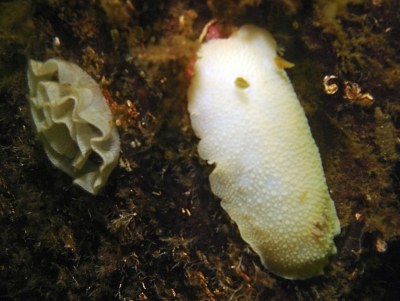
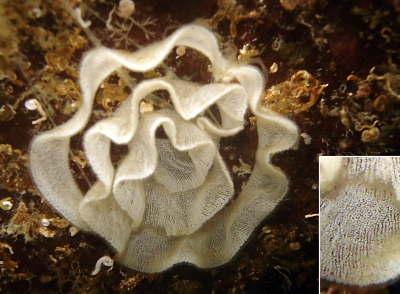
Seeing the proximity of the individual to the egg mass and images in Andy Lamb and Bernie Hanby's "Marine Life of the Pacific Northwest " we believe this is the egg mass of Doris odhneri.
Locality: Escape Reef (Stuart Channel) near Kuper Island , 52 feet, British Columbia, Canada, Pacific Ocean, 14 April 2007, Wall. Length: 18 cm . Photographer: Jackie Hildering and Glen Miller.
Jackie Hildering & Glen Miller
earthlingenterprises@telus.net
Hildering, J. & Miller, G., 2007 (Jul 27) Doris odhneri eggs?. [Message in] Sea Slug Forum. Australian Museum, Sydney. Available from http://www.seaslugforum.net/find/20168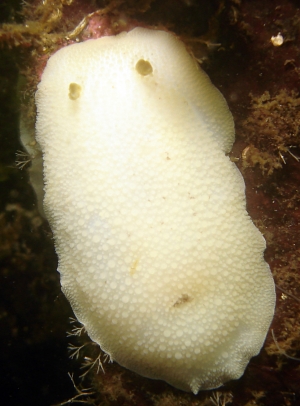
Hi Jackie and Glen,
I tend to agree with you. Thanks for sharing
Best wishes,
Dave Behrens
Re: Doris odhneri feeding
July 11, 2007
From: Dave Behrens
Concerning message #19273:
Hi Bill:
From what I can find in the literature, Jan is correct. Morris, Abbott & Haderlie (1980), Gotshall (2005), and the newly published "The Sponges of California" (Lee, Elvin and Reiswig, 2007) all call it Haliclona sp. Interestingly, Lamb & Hanby (2005) do not include it.
Dave
dave@seachallengers.com
Behrens, D.W., 2007 (Jul 11) Re: Doris odhneri feeding. [Message in] Sea Slug Forum. Australian Museum, Sydney. Available from http://www.seaslugforum.net/find/20187Thanks Dave,
I guess after just trying to sort out published sponge indentifications for my review of feeding in the chromodorids recently, I have been shocked at how often sponges are misidentified in the literature. Sometimes it is because a species was misidentified 100 years ago and the error has been repeated over generations, sometimes it is a recent error by a book publisher in search of a name, but in most cases it is a reflection of how few sponge taxonomists there are and how much work still needs to be done.
Often its not just a simple misidentification, but a complicated nomenclatural or taxonomic problem - for example a species may have been originally placed in the wrong genus and the error has never been corrected, so even though it has always been called Tethya xus for example, it may really be in a different family. That is not to say that the books you cite are all full of errors - I have no idea .. but I suspect that if sponge taxonomy on the Nth American west coast is like most sponge taxonomy, then there is a possibility that identifications based on 'tradition' and 'common usage' and not based on recent research and revisions could prove to be wrong. Which leaves us non-experts with a problem.
Bill Rudman
Doris odhneri feeding
July 11, 2007
From: Jan Kocian
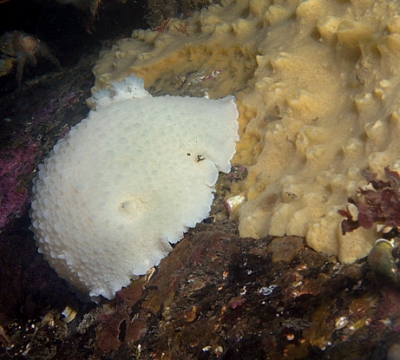
Hello Bill.
Since you are always looking for slug's feeding, I am enclosing couple pictures of Doris odhneri making a dent into a patch of encrusting sponge Haliclona.
Locality: Jetty, 18 feet, Washington, USA, Puget Sound, NE Pacific Ocean, 15 January 2007, rocks. Length: 40 mm. Photographer: Jan Kocian.
Jan Kocian
honkoc@hotmail.com
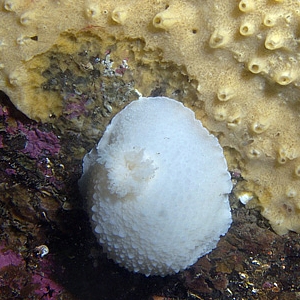
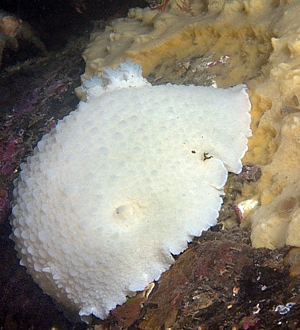
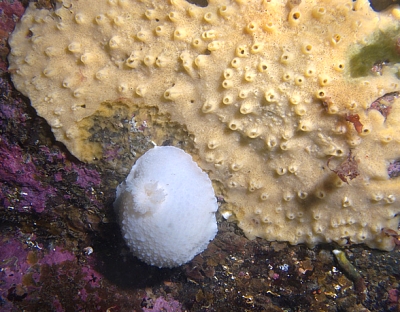
Dear Jan,
There is no ambiguity in this observation! It is definitely feeding. I would be grateful if anyone with a knowledge of the sponges of the area could confirm the identity of the sponge. It looks more like a species of Halichondria than a species of Haliclonato me
Best wishes,
Bill Rudman Rudman, W.B., 2007 (Jul 11). Comment on Doris odhneri feeding by Jan Kocian. [Message in] Sea Slug Forum. Australian Museum, Sydney. Available from http://www.seaslugforum.net/find/19273
Archidoris odhneri from British Columbia
October 24, 2003
From: Bruce Wight
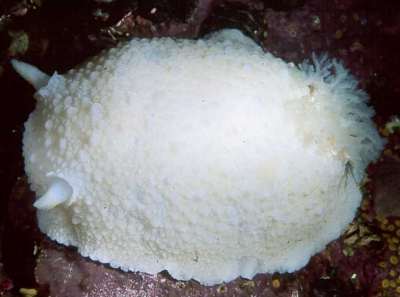

Dear Bill
Here are some photos of an Archidoris from our recent trip to British Columbia.
Johanna and I were up at the Northern end of Vancouver Island the first week of October diving around Port Hardy and Browning Pass, British Columbia. This was our first time diving in Canada.
Is it an Archidoris odhneri?
Take care,
Bruce Wight
bwproductions@earthlink.net
Wight, B., 2003 (Oct 24) Archidoris odhneri from British Columbia. [Message in] Sea Slug Forum. Australian Museum, Sydney. Available from http://www.seaslugforum.net/find/11282Thanks Bruce,
I am pretty sure this is Archidoris odhneri. If it isn't I am sure someone will let us know
Best wishes
Bill Rudman
Yellow Phase of Archidoris odhneri
October 5, 2003
From: Clinton Bauder
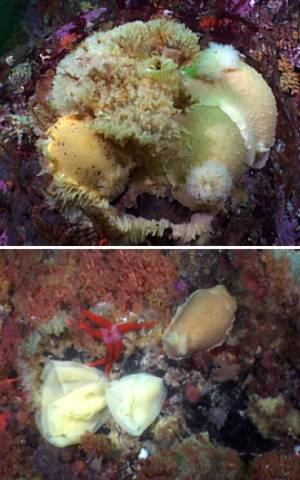
Hi Bill,
I'm back from another Alaska trip. This trip wasn't as successful from a nudibranch standpoint as previous trips north but that may have had as much to do with my new wide angle video setup (= not the best for shooting nudibranchs) as anything else. As usual, though, the diving was excellent.
Anyway I saw several of these large (15 cm or more) yellow dorids which I believe are Archidoris odhneri. The pictures are from St Lazarius Island which is near Sitka, Alaska. Depth was about 20m. Interestingly a couple of times I found them sharing a food-sponge (Myxilla lacunosa?) with a brown-spotted yellow dorid I identified as Archidoris montereyensis (see lower left of the uppermost photo).
Clinton
gecko1@apple.com
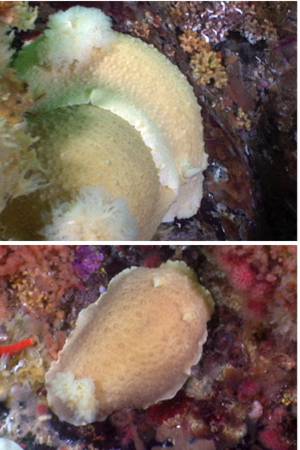
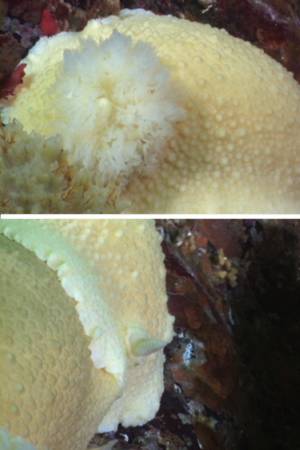
Thanks Clinton,
Your animals certainly look like Archidoris odhneri but I am too much of a coward to agree or disagree with your identification of the brown-spotted yellow animal in the top photo.
Best wishes
Bill Rudman
Archidoris odhneri from Carmel, California
June 24, 2002
From: Clinton Bauder
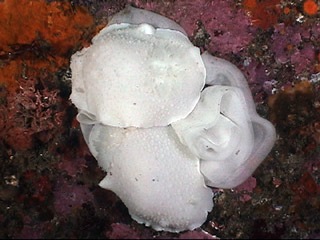
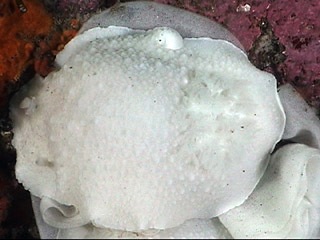
Hi Bill,
Saw this pair of mating Archidoris odhneri this month at South Monastery Beach in Carmel California. Depth was about 13m. They are about 130mm in length.
Clinton
gecko1@apple.com
Bauder, C., 2002 (Jun 24) Archidoris odhneri from Carmel, California. [Message in] Sea Slug Forum. Australian Museum, Sydney. Available from http://www.seaslugforum.net/find/7311Thanks Clinton,
For these two to be mating, they would have to have their right, rather than their left sides together. I suppose its possible the photo is reversed, but even so I don't know why they would me sitting on top of egg masses to mate. The other, and more likely possibility is that they are both laying their eggs close together for some reason.
Cheers,
Bill Rudman
